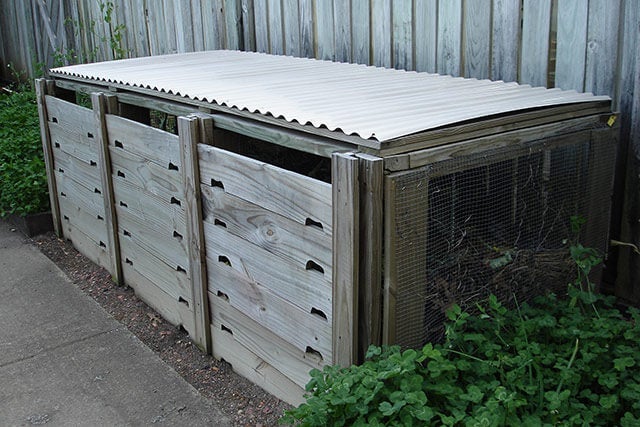There are as many ways to make a compost pile as there are gardeners. You can create a free-standing compost heap, which is literally a mound or pile (preferably out of sight). If you'd prefer a ready-made one, you can buy a compost bin — there are many styles to choose from. Another option is to build your own bin out of lumber (recycled wooden pallets work great) and wire-mesh fencing.
The Ingredient Layers
Any material that was once a plant, from asparagus trimmings to autumn leaves, can be composted. Most households generate a steady stream of compost materials from the kitchen, garden, and landscape. Begin layering organic materials such as leaves, straw, old corn stalks, weed-free and pesticide-free grass clippings, egg shells, coffee grounds, tea, fruit peels, and other organic matter from the kitchen; just avoid meats, greasy ingredients, and pet droppings. If most of the compost materials at your house come from your kitchen, consider using an enclosed, or stationary, composter. In addition to keeping the compost hidden from view, stationary composters discourage unwanted visits from animals.
The bigger your garden, the more you will need a good place to compost its waste. An open pile that can be chopped and turned quickly works well for composting garden waste. Leaves need to weather for a while before they decompose, so it is often best to stockpile them in a bin through the winter. In spring, the weathered leaves can be used as mulch, or you can combine them with kitchen and garden waste to help them decompose a little faster. Some gardeners chop leaves with a mulching mower or leaf shredder to speed decomposition.
If you're starting a new pile, sprinkle it with a couple of shovelfuls of topsoil or previously composted materials to add the needed microorganisms for decomposition. A sprinkle of organic fertilizer (such as blood meal or feather meal) adds nitrogen that will help increase the rate of decomposition as well.
If you are creating an open-air pile, continue layering these items (according to the guidelines below) until your mix is 3 to 4 feet tall. Water between layers, but don't make the pile soggy. If you put your materials in a purchased compost tumbler, just add and tumble.

Balancing Browns and Greens
There is no precise recipe or formula for making compost beyond the simple ratio of 3 parts "browns" to 1 part "greens." As shown in the list below, most "browns" come from trees, and they are rich in carbon (often abbreviated as C in composting lingo). "Greens" come from fresher, juicier materials, like garden and kitchen waste, but any ingredient that is rich in nitrogen (N) qualifies as a green.
Every gardener has plenty of greens in summer, followed by an abundant supply of browns in the fall. To make it fast and convenient to balance your compost, save up shredded leaves and pine needles in the fall, and store them in trash bags, an old garbage can, or a large wire pen. In summer, should watermelon rinds and spent plants overload your compost with greens, layering on some leaves will set things to right. Composters who live in areas where leaves are scarce often use shredded newspaper to keep summer compost from going gloppy with too many greens.
If your garden is small yet your yard has many trees, your compost may need additional greens to balance all the browns from collected leaves. Grass clippings from lawns that have not been treated with herbicides will give fast results when mixed into a stalled leaf-based compost, or you can energize it with high-nitrogen plant meals like alfalfa, canola, or cottonseed meal. When sprinkled in among layers or mixed in well, organic fertilizers made from poultry manure provide nitrogen for compost, too.
When made of 3 parts "browns" and 1 part "greens," any compost will make good progress.






Typical Browns
- Leaves
- Pine needles
- Hay or straw
- Newspapers or cardboard
- Sawdust
Typical Greens
- Kitchen waste
- Grass clippings (untreated)
- Coffee grounds
- Manure and other organic fertilizers
Air, Water, and Stirring
Air and water are the secrets to good composting. Keep the materials moist and well aerated. Water the compost regularly, then add air to speed the process by turning the compost with your turning fork. Don't like stirring by hand? Put compost materials in a plastic garbage can covered by a tight-fitting lid with air holes drilled into it, then roll the can to stir the materials inside. Or, purchase a "tumbler" composter that can be turned via a handle.
Compost Does Happen
If you turn the ingredients every week or two, the compost will form more rapidly than if you don't. Some people turn their piles religiously, while others rarely do. Compost will happen — but you have a lot of control over how fast it will happen.
Good, finished compost has a pleasant, earthy smell, and looks like rich brown soil. An unpleasant odor is the sign of too much water or too many green ingredients, or that the compost isn't done "cooking" yet. Try turning the pile more often, reducing the moisture content, and/or adding dry, brown ingredients such as leaves or straw to balance the mix.




 Herbs
Herbs
 Vegetables
Vegetables
 Fruit
Fruit
 Flowers
Flowers
 Succulents
Succulents


